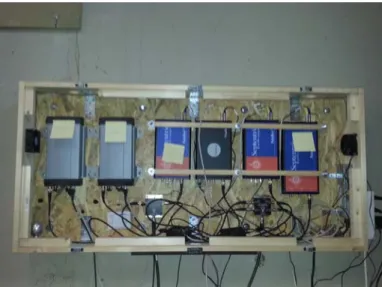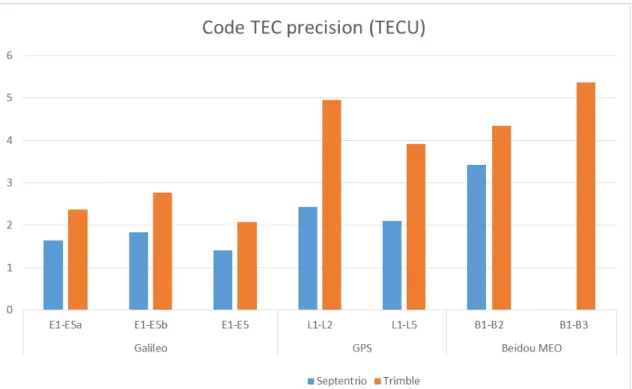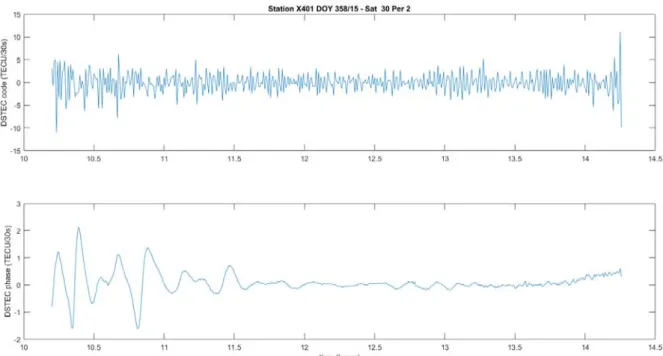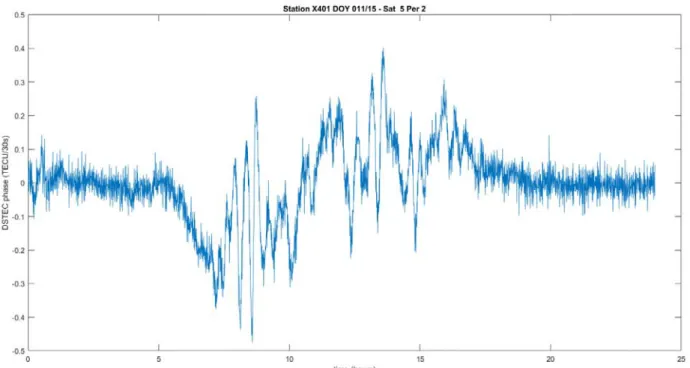THE ADDED VALUE OF NEW GNSS FOR IONOSPHERE MONITORING
R. Warnant, C. Deprez University of Liege Quartier Agora Allée du 6 Août, 19 B-4000 Liege (Belgium) Email:Rene.Warnant@ulg.ac.be INTRODUCTIONFor the last 25 years, the ionosphere Total Electron Content (TEC) has been reconstructed from GPS L1/L2 code and phase measurements in order to mitigate ionospheric effects on satellite-based positioning [1] [2]. Depending on the application and on the positioning technique, the error due to the ionosphere is influenced by absolute TEC and/or TEC gradients. In particular, local variability in the Total Electron Content also referred to as “irregular gradients” can strongly degrade the performances of differential or relative positioning applications [3]. Irregular gradients in TEC are due to different types of ionospheric “disturbances”. At European mid-latitudes, the most frequent disturbances are Medium-Scale Travelling Ionospheric Disturbances (MSTIDs) [4].
GNSS-BASED TEC MONITORING
The absolute slant TEC can be obtained from the geometry-free combinations of code and phase pseudoranges; using the frequency pair
f
k,
f
l :1 , ,
(
, ,) (
,)
, , i i i i i i p c kl kl p k p l kl p kl p kl p klSTEC
P
P
d
d
M
(1) 1 , ,(
, ,) (
,)
, ,(
, ,)
i i i i i i i i p kl kl p k p l kl p kl p kl p kl k p k l p lSTEC
m
(2) With : , ,,
, , i i p c kl p klSTEC
STEC
: Slant TEC (TECU) between satellite “i” and receiver “p” obtained from the code and phase geometry-free combinations at frequenciesf
k,
f
l;,
,
, i i p k p lP
P
: code pseudorange observables (m) for satellite “i” and receiver “p” at frequenciesf
k,
f
l; ,,
,i i p k p l
: phase pseudorange observables (m) for satellite “i” and receiver “p” at frequenciesf
k,
f
l; ,,
i kl p kld
d
: satellite “i” and receiver “p” code inter-frequency biases (IFB) between frequenciesf
k,
f
l; ,i kl p kl
: satellite “i” and receiver “p” phase inter-frequency biases (IFB) between frequenciesf
k,
f
l; ,,
,i i p kl p kl
M
m
: code and phase multipath (m); ,,
,i i p kl p kl
E
: code and phase noise (m); , ,i i p k p l
: phase ambiguities (cycles) at frequenciesf
k,
f
l;,
k l
: wavelengths (m) corresponding tof
k,
f
l. And : 16 2 21
1
40,3 10
kl k lf
f
(3)Absolute slant TEC precision depends on code and phase pseudorange precision (noise), on multipath, on inter-frequency biases and also on the magnitude of
kl1which is a function of the selected frequency pair. This coefficient will be referred to as “TEC coefficient”. Phase observables are usually preferred to code observables due to their better precision. Nevertheless, phase-based absolute TEC reconstruction requires the computation of a non-integer ambiguity. For this reason, the accuracy of phase-based TEC mainly depends on the ambiguity computation process. Most existing techniques use code levelling to compute the ambiguity term [1]. In this case, TEC accuracy is degraded due to thelower precision of the code geometry-free combination. In practice, the accuracy of GPS L1/L2 absolute TEC usually ranges between 2 and 5 TECU.
The occurrence of ionospheric disturbances which can pose a threat to relative and differential positioning techniques can be detected by monitoring the (phase-based) rate of TEC change, i, ,
p kl
STEC
(i.e. TEC change between 2 consecutive epochs,t
k1,
t
k) at a single station:, ,
( )
, ,( )
, ,(
1)
i i i
p kl k p kl k p kl k
STEC
t
STEC
t
STEC
t
(4)In (4), i, , p kl
STEC
is neither mapped to vertical nor normalized to a one-minute time interval. This combination removes biases (ambiguities and constant part of IFBs) but it still depends on noise and on between-epoch change in TEC, multipath and IFBs, the latter being generally regarded as negligible. GPS-based detection of moving structures like MSTIDs is affected by an observational bias which is due to GPS satellite orbital motion [4]. Indeed, most of GNSS satellites and, in particular, GPS satellites are placed on Medium Earth Orbits (MEO) at an altitude around 20 000 km. This means that they have a velocity with respect to the ionosphere. MSTIDs are moving structures and therefore have also a velocity with respect to the ionosphere. In practice, MSTID detection is affected by the relative velocity between the TID and the satellite. For a given TID, the fact that the satellite has a velocity which is parallel, anti-parallel (worst case) or perpendicular to the MSTID velocity has an influence. For example, if the TID has a velocity which is anti-parallel and of the same order of magnitude than the satellite velocity, there is a high probability that the MSTID will not be detected. In other words, the study of ionospheric disturbances using GPS satellites has an “observational bias” which makes TID modelling more difficult.Nowadays, new or modernized GNSS are providing multi-frequency signals which allow to form geometry-free combinations from several frequency pairs; some of these new GNSS signals like Galileo E5 are more precise and more resistant to multipath. In addition, dual or even triple frequency measurements become available from GEO satellites (SBAS and Beidou). These satellites do not have any significant velocity with respect to the ionosphere. In a first step, we analyze the precision on GNSS-based TEC which can be obtained from the different frequency pairs presently available with GPS, Galileo and Beidou. Then, we investigate the possibility to use GEO navigation satellites to detect MSTIDs at European mid-latitudes.
TEC PRECISION
Our study is mainly based on 6 multi-frequency and multi-constellation receivers located on the roof of our building at the University of Liege (Belgium); we own 1 Septentrio PolaRxS, 2 Septentrio PolaRx4, 1 Septentrio PolaRx5 and 2 Trimble NetR9 receivers (Fig. 1). This equipment is connected to 2 Trimble choke ring GNSS antennae through a 2-way and a 4-2-way splitter. The baseline between these antennae is very short (5.35 m).
Based on real data collected by theses receivers in short baseline mode, the paper analyses the precision in TEC reconstruction which can be obtained from the different frequency pairs formed with GPS (L1, L2, L5), Galileo (E1, E5, E5a, E5b, E6) and Beidou phase II (B1, B2, B3). As already mentioned, TEC precision mainly depends on code and phase observables precision and on the TEC coefficient
kl1.Table 1. TEC coefficients for different GPS, Galileo and Beidou frequency pairs.
Table 1 shows the TEC coefficients for different frequency pairs. If all the code (resp. phase) observables had the same precision (it is not the case in reality), GNSS-based TEC precision would mainly depend on the magnitude of the TEC coefficient which should be as small as possible. In this case, Galileo E1/E5a and GPS L1/L5 would give the best frequency pair with a value of 7.764 compared to 9.52 for GPS L1/L2. The worse frequency pairs are GPS L2/L5 (42,089) and Galileo E1/E6 (11,893). Therefore, these 2 pairs will not be considered in our study.
In order to assess GNSS-TEC precision, we use the following strategy: for a given GNSS/frequency pair, we compute (code and phase) i,
p kl
STEC
on 30 second intervals; then, we form single (i.e. between-receiver) differences of ,i p kl
STEC
on our short baseline (we only form single difference between identical receiver types); this combination removes the ionosphere but still contains noise in addition to residual influence of multipath and IFBs, the latter being usually negligible. Fig. 2 shows an example of this combination for Galileo satellite E30 and frequency pair E1/E5.Fig. 2. Single difference of code (top) and phase (bottom) E1/E5 rate of TEC (in TECU/30 sec) between 2 Septentrio PolaRx4 receivers for Galileo satellite E30 observed in Liege on DOY 022 in 2016.
We formed this combination for Galileo (E1/E5a, E1/E5b, E1/E5), GPS (L1/L2, L1/L5) and Beidou (B1/B2, B1/B3) using all satellites in view in Liege during a 10-day period; then we computed the standard deviation over the whole period and we divided the obtained value by 2 (error propagation) to have the precision on TEC. Let’s mention that the Septentrio PolaRx4 receivers do not track Beidou B3.
Fig. 3 displays the precision of code-based TEC (an elevation mask of 10° has been applied and the receiver multipath mitigation algorithms have been switched off): it ranges between 1,5 and 5 TECU depending on constellations/pairs/receiver types; Septentrio PolaRx4 receivers provide better code-TEC accuracy than Trimble NetR9 receivers for all the considered frequency pairs/constellations. On the other hand, Galileo E1/E5a, E1/E5b and particularly E1/E5 frequency pairs give the best results.
Fig. 4 shows code-based TEC precision obtained with Septentrio PolaRx4 receivers applying a 20° elevation mask and switching the multipath mitigation algorithm on: in that case, 4 frequency pairs, GPS L1/L5, Galileo E1/E5a, E1/E5b and E1/E5 provide precisions better than 1 TECU. Depending on the application and given the accuracy of the Galileo E1/E5 pair, TEC could be reconstructed directly from code measurements avoiding to solve phase ambiguities; this would make the data processing techniques more robust in case of disturbed ionosphere where additional ambiguities must often be computed due to the occurrence of cycle slips. In addition, in the case of phase-based TEC, the availability of very precise codes will improve the code levelling step leading to a more accurate phase-based TEC.
TEC coefficients
Galileo GPS Beidou
E1-E5a E1-E5b E1-E5 E1-E6 L1-L2 L1-L5 L2-L5 B1-B2 B1-B3
Fig. 3. Precision of code-based TEC for different constellations/frequency pairs and 2 receiver types (receiver multipath mitigation off, 10° elevation mask).
Fig. 4. Precision of code-based TEC for different constellations/frequency pairs and Septentrio PolaRx4 receivers (receiver multipath mitigation on, 20° elevation mask).
Nevertheless, code-based Galileo E1/E5 rate of TEC is not precise enough to detect MSTIDS. This fact is illustrated in Fig. 5 where the code-based and phase-based Galileo E1/E5 rate of TEC have been represented: a very strong MSTID is detected in the phase-based combination when nothing can be extracted from the noise of the code-based combination.
Fig. 5. E1/E5 code-based (top) and phase-based (bottom) rate of TEC (in TECU/30 sec) for Galileo satellite E30. Fig. 6 displays the precision of phase-based TEC (an elevation mask of 10° has been applied and the receiver multipath mitigation algorithms have been switched off): it ranges between 0.008 and 0.017 TECU with rather small differences between constellations/pairs/receiver types. Again, Galileo and, in particular, the pair E1/E5 gives the best results.
Fig. 6. Precision of phase-based TEC for different constellations/frequency pairs and 2 receiver types (receiver multipath mitigation off, 10° elevation mask).
DETECTION OF IONOSPHERIC IRREGULARITIES USING GEO NAVIGATION SATELLITES
Finally, we discuss the capability of GEO satellites to monitor the occurrence of MSTIDs at European mid-latitudes. MSTIDs usually cause a variability in TEC ranging from 0.1 TECU/min up to several TECU/min. In Liege (Belgium), there are 5 dual or triple frequency GEO satellites in view: Beidou C02 (1-2° elevation) and C05 (15° elevation), GAGAN S127 (16° elevation), EGNOS S123 (27° elevation) and S136 (32° elevation). In this paper, we limit our analysis to Beidou satellites which give the best results. Only phase-based TEC is considered.
Fig. 7. Phase-based TEC precision for Beidou C02 (1-2° elevation) and C05 (15° elevation) tracked by Septentrio PolaRx4 receivers (multipath mitigation switched on).
In practice, all our Septentrio receivers (PolaRx4, PolaRxS and PolaRx5) are able to track both C02 and C05 satellites; C05 data are continuous: in average, we experience less than 1 cycle slip per day meaning that the phase ambiguities often remain the same during several days. Despite the very low satellite elevation, C02 data are usually continuous during several hours and sometimes up to 24 hours. Our Trimble NetR9 receivers are only able to track C05 but the data are unusable due to many cycle slips. Fig. 7 shows phase-based TEC precision for C02 (0.045 TECU) and C05 (0.023 TECU) satellites. Due to error propagation, the precision on rate of TEC becomes 0.064 TECU/30 s for C02 and 0.032 TECU/30 s for C05 which is sufficient for TID detection.
Fig. 8. Phase-based rate of TEC (TECU/30 sec) for satellite C05 on DOY 011 in 2015.
As an illustration, Fig. 8 displays the rate of TEC change computed for C05 satellite on DOY 011 in 2015: the occurrence of a TID can be observed between 7h00 and 09h00. Let’s recall that this combination depends on between-epoch change in TEC, multipath and IFBs. We verified that the variability observed between 07h00 and 09h00 was due to the ionosphere and not multipath (at the station), on the one hand, by comparing the same combinations obtained on the same day in neighboring stations and, on the other hand, the combinations obtained in Liege during several consecutive days; indeed, for GEO satellites, multipath should have a repeatability of 24 hour sidereal time. In addition, we analyzed the Simsky combination [6] which allowed us to demonstrate that the above-mentioned variability was not due to multipath (at the satellite) or to variability in the IFBs.
CONCLUSIONS
In this paper, we demonstrated that new or modernized GNSS signals give the opportunity to form geometry-free combinations from different frequency pairs. We compared the precision of TEC computed from these new frequency pairs to the precision obtained with GPS L1/L2. Code-based TEC precision ranges between 1,5 and 5 TECU depending on constellations/pairs/receiver types; Galileo E1/E5a, E1/E5b and particularly E1/E5 frequency pairs give the best results. Phase-based TEC precision ranges between 0.008 and 0.016 TECU with rather small differences between constellations/pairs/receiver types. Again, Galileo and in particular the pair E1/E5 give the best results. Finally, we showed that phase-based TEC reconstructed from Beidou GEO satellites C02 (1-2° elevation) and C05 (15° elevation) is accurate enough to monitor the occurrence of MSTIDs. GEO satellites have the advantage to have a negligible velocity with respect to the ionosphere: this is a major added value for the detection of moving structure in the ionosphere.
REFERENCES
[1] R. Warnant and E. Pottiaux, “The increase of the ionospheric activity as measured by GPS”, Earth Planets Space, vol. 52, pp. 1055-1060, 2000.
[2] L. Ciraolo, F. Azpilicueta, C. Brunini, A. Meza, S. M. Radicella, “Calibration errors on experimental slant total electron content (TEC) determined with GPS”, Journal of Geodesy, vol. 81, pp. 111-120, 2007.
[3] S. Lejeune, G. Wautelet and R. Warnant, “Ionospheric effects on relative positioning within a dense GPS network”, GPS Solutions, vol. 16, pp. 105-116.
[4] G. Wautelet and R. Warnant, “Climatological study of ionospheric irregularities over the European mid-latitude sector with GPS”, Journal of Geodesy, vol. 88, pp. 223-240, 2014.




